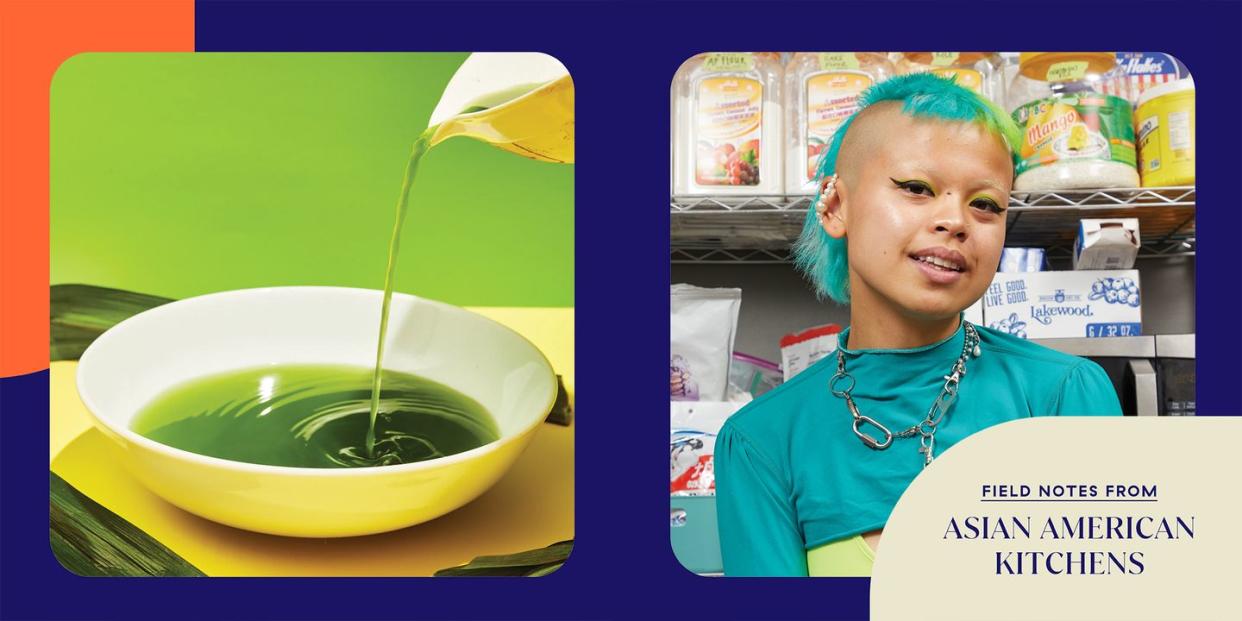Pandan Offers A Singular Taste Of Home For Southeast Asians

Growing up in a Filipino household, I was introduced to pandan at an early age. Whether I was eating pandan puto (steamed rice cake) or pandan polvoron (crumbly shortbread), I leapt at the chance to try pandan-flavored anything.
Pandan, or screwpine, is an essential ingredient in Southeast Asian cuisine. It has a delicate tropical flavor that I can only describe as a unique combination of vanilla and almond. It’s commonly paired with coconut in a wide array of dishes. In the United States, I haven’t come by these long, slender leaves harvested fresh, but I have seen them frozen and in extract or paste form at Asian grocery stores. When using the frozen leaves, you can easily thaw them and tie them into knots for steeping in any liquid.
Much like ube, Filipino purple yam, pandan can be seen as trendy much in part to its sweet flavor and the fun color it imparts to a dish. While Nigella Lawson posited it would be the next “it” ingredient in the West in 2017, it has long been known as a staple in Southeast Asia. For those of us in the Asian American diaspora, I don’t recall a time when pandan bubble waffles weren’t a thing at boba or bubble tea shops. Those aesthetically pleasing green waffles tasted extra delicious when you washed them down with taro milk tea.
If we go way back, we can trace the origins of Pandanus amaryllifolius to the Moluccas, the archipelago east of Indonesia, where the only known flowering specimen was found. From there, the plant spread through Southeast Asia and Sri Lanka, where people first started cultivating and using it as a flavoring for consumption. Besides its use in food, the scent of pandan can apparently ward away cockroaches, and when the leaves are steeped in coconut oil, the salve can help with rheumatism.
Although I’ve never tried those other uses of pandan, it might be because I’ve spent all my time eating pandan-flavored desserts. I’d always devour buko pandan salad at family parties. It’s a refreshing Filipino dessert that consists of a chewy and cold mixture of nata de coco (coconut gel), gulaman (agar-agar jelly), strings of fresh buko (young coconut) and kaong (sugar palm fruit) covered in thickened, sweetened cream. Pandan is used to flavor the gulaman and even the cream itself sometimes. Growing up in San Jose—which has one of the largest Little Saigons in the world—I was fortunate to be around a plethora of Vietnamese restaurants. Another pandan staple I loved getting was Bánh Bò Nướng, which is a Vietnamese sponge cake with a unique honeycomb texture. I looked forward to ordering it just because of its light green hue and fragrant scent of pandan.
Pandan’s versatility makes it not only a wonderful addition to a dessert table, but also a vital component in more savory dishes. When you wrap the fragrant leaves around marinated chicken in the Thai dish Gai Hor Bai Toey, the flavor is imparted through the leaves in the cooking process. Although the leaves are much thinner than that of banana leaves, the idea behind using it as a flavorful wrapper is very similar in practice. Jasmine rice steamed with pandan has a grassy aroma and is so complementary with coconut milk-based curries and stews.
Even now, I seek out pandan flavors in my everyday life. Whether I’m baking with it or eating pandan-flavored food like these pandan pops, it feels like a gentle reminder of my own childhood. For heart-shaped cakes I make for friends’ birthdays, I love using both pandan and ube extracts to swirl two-toned neon batters reminiscent of Y2K Heinz EZ Squirt Ketchup (though I hope my cakes are met with more positive feedback than the stomach-churning reviews of this defunct condiment).
For breakfast, pandan-flavored jams also come in handy. Cooking down sugar, coconut milk, eggs and pandan leaves helps turn the mixture into a delicious jam called kaya that is a favorite in Malaysia, Singapore, and Indonesia. When I don’t want to spend any time making kaya myself, I buy Mariza Srikaya pandan jam to spread onto buttered toast. If you have pandesal (Filipino bread rolls) or fluffy milk bread, the jam tastes even better with that combo.
If I’m wandering around the East Village in New York City, my favorite sweet shop to get rainbow lapis is Lady Wong Pastry & Kuih. Kuih or kueh lapis are steamed sticky layered rice cakes flavored with pandan and coconut, and the rainbow variety gets its namesake from its colorful motif. It’s another classic dessert you can typically find in Malaysia, Singapore and Indonesia. It’s so much fun to peel back each layer and eat a slab of red and then yellow, and green. No matter where I’m getting pandan, it’s a singular flavor that tastes like home.

You Might Also Like

